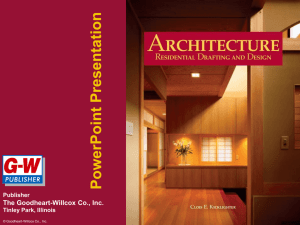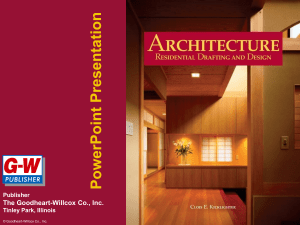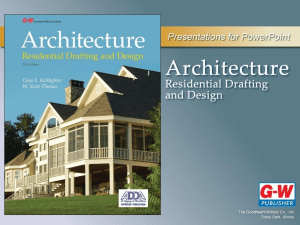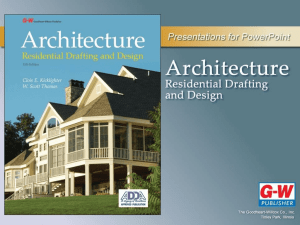Arch11 basement plan
advertisement
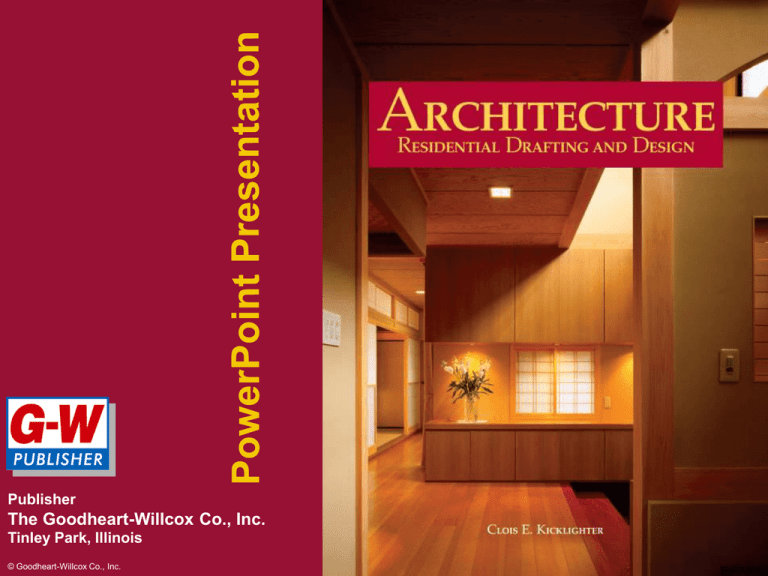
Publisher The Goodheart-Willcox Co., Inc. Tinley Park, Illinois © Goodheart-Willcox Co., Inc. 1 Permission granted to reproduce for educational use only Chapter 17 Footings, Foundations, and Concrete 2 © Goodheart-Willcox Co., Inc. Permission granted to reproduce for educational use only Frost Penetration Chart • Average depth of frost penetration in inches. (US Department of Commerce Weather Bureau) © Goodheart-Willcox Co., Inc. 3 Permission granted to reproduce for educational use only Footing Shapes • Footings increase supporting capacity of the foundation wall. • Most houses require footings. • Soil bearing capacity and weight of house determine the size and type of footing. • Footings are generally poured concrete. • Footing size is typically based on the foundation wall thickness. 4 © Goodheart-Willcox Co., Inc. Permission granted to reproduce for educational use only Footing Shapes • A footing expands load bearing area. 5 © Goodheart-Willcox Co., Inc. Permission granted to reproduce for educational use only Footing Shapes • General proportions of a footing. 6 © Goodheart-Willcox Co., Inc. Permission granted to reproduce for educational use only Footing Specifications • Footing thickness generally equals the foundation wall thickness. • Footing width is twice the wall thickness. • Poor soil may require wider footings. • Settling occurs during construction. • Prevent uneven settling. • Check code recommendations. • Use steel reinforcing bars. 7 © Goodheart-Willcox Co., Inc. Permission granted to reproduce for educational use only Fireplace and Chimney Footings • Fireplace and chimney footings are more massive than regular house footings. – Should be reinforced with steel. – 12 inches thick. – Extend 6 inches beyond the perimeter of the chimney. – Cast integrally with house footing. 8 © Goodheart-Willcox Co., Inc. Permission granted to reproduce for educational use only Foundation Walls • Extend from the first floor to the footing. • May also be basement walls. • Variety of materials may be used: – Cast concrete, concrete block, pressuretreated wood, and stone or brick. • Four basic types of foundation walls: – T-foundation, slab foundation, pier and post foundation, and wood foundation. 9 © Goodheart-Willcox Co., Inc. Permission granted to reproduce for educational use only Foundation Walls • Foundation wall materials. 10 © Goodheart-Willcox Co., Inc. Permission granted to reproduce for educational use only Foundation Walls • Foundation types. 11 © Goodheart-Willcox Co., Inc. Permission granted to reproduce for educational use only T-Foundations • The T-foundation is the most common type of residential foundation. – Name is derived from the shape. – Footing and foundation wall are usually separate parts. – Footings are usually cast in forms. – Variety of applications of T-foundation. 12 © Goodheart-Willcox Co., Inc. Permission granted to reproduce for educational use only T-Foundation Application • 8" basement wall and footing. 13 © Goodheart-Willcox Co., Inc. Permission granted to reproduce for educational use only Post (Column) Foundation • A pipe or adjustable jack post is frequently used to support a beam. This is a column or post foundation. 14 © Goodheart-Willcox Co., Inc. Permission granted to reproduce for educational use only Post (Column) Foundation 15 © Goodheart-Willcox Co., Inc. Permission granted to reproduce for educational use only Pilasters • Pilasters may be used to strengthen basement walls. • Built at the same time as the wall. • Masonry wall pilasters are usually 8" x 16" in an 8" thick wall. • Distance between pilasters should not exceed 15' in an 8" wall and 18' in a 10" wall. • Pilasters are also used to support beams. 16 © Goodheart-Willcox Co., Inc. Permission granted to reproduce for educational use only Pilasters 17 © Goodheart-Willcox Co., Inc. Permission granted to reproduce for educational use only Firecuts • A firecut is used when floor joists are placed directly into solid masonry walls. • Each joist end is cut at an angle to prevent wall damage in case of fire. 18 © Goodheart-Willcox Co., Inc. Permission granted to reproduce for educational use only Water Removal Method • Drain tile placement. 19 © Goodheart-Willcox Co., Inc. Permission granted to reproduce for educational use only Floor Slabs • A concrete floor slab should be placed on 4" to 6" of compacted sand. • Slab thickness is 4" minimum. • Slabs should not be bonded to footings or columns. • A 1" thick sand cushion may be used to separate the slab from the footing. 20 © Goodheart-Willcox Co., Inc. Permission granted to reproduce for educational use only Floor Slab Section 21 © Goodheart-Willcox Co., Inc. Permission granted to reproduce for educational use only Chapter 14 The Foundation Plan 22 © Goodheart-Willcox Co., Inc. Permission granted to reproduce for educational use only The Foundation Plan • The foundation plan is a plan view drawing in section. – Shows the location and size of footings, piers, columns, foundation walls, and supporting beams. – Usually drawn after the floor plan and elevations have been roughed out. 23 © Goodheart-Willcox Co., Inc. Permission granted to reproduce for educational use only Foundation Plan Features • The following features are shown on a foundation plan: – Footings for walls, piers, and columns. – Foundation walls. – Piers and columns (posts). – Dwarf walls. – Partial walls, doors, and bath fixtures (basement). – Openings in foundation wall. (continued) 24 © Goodheart-Willcox Co., Inc. Permission granted to reproduce for educational use only Foundation Plan Features – Beams and pilasters. – Direction, size, and spacing of floor joists or trusses. – Drains and sump (if required). – Details of foundation and footing construction. – Complete dimensions and notes. – Scale of drawing. 25 © Goodheart-Willcox Co., Inc. Permission granted to reproduce for educational use only Foundation Plan Symbols 26 © Goodheart-Willcox Co., Inc. Permission granted to reproduce for educational use only Drawing a Foundation Plan • Completed foundation plan. 27 © Goodheart-Willcox Co., Inc. Permission granted to reproduce for educational use only Chapter 13 The Floor Plan 28 © Goodheart-Willcox Co., Inc. Permission granted to reproduce for educational use only Windows and Doors • Use a centerline to locate the opening for windows and doors in frame walls. • Dimension to the side of the opening in a masonry wall. • Openings for windows are sash width. • Openings for doors are actual width. • Sills are drawn for windows and exterior doors. • Door swing should be indicated. 29 © Goodheart-Willcox Co., Inc. Permission granted to reproduce for educational use only Window and Door Location • Windows and doors should be located in a frame wall using a centerline. Door swing is also shown. 30 © Goodheart-Willcox Co., Inc. Permission granted to reproduce for educational use only Stairs and Fireplaces • Only information about the basic size and location of stairs and fireplaces needs to be recorded on the floor plan. • For stairs, show direction of flight, number of risers, and width of stairs. • For a fireplace, show basic depth and width, opening design, and location. – Use either simplified or detailed symbol. 31 © Goodheart-Willcox Co., Inc. Permission granted to reproduce for educational use only Stairs on Floor Plan • Information about a set of stairs that is usually included on the floor plan. 32 © Goodheart-Willcox Co., Inc. Permission granted to reproduce for educational use only Room Names • Room names help communicate the plan to others. • Room names should be 3/16" high. • Room names should be in the center of the room. • Approximate room size should appear below the name. 33 © Goodheart-Willcox Co., Inc. Permission granted to reproduce for educational use only Material Symbols • Material symbols or material hatch patterns are used to denote each material. • Use a material symbol whenever the material should be identified. • If the symbol is not a standard one, identify it. 34 © Goodheart-Willcox Co., Inc. Permission granted to reproduce for educational use only Material Symbols 35 © Goodheart-Willcox Co., Inc. Permission granted to reproduce for educational use only Material Symbols 36 © Goodheart-Willcox Co., Inc. Permission granted to reproduce for educational use only Dimensioning • Dimensions on a floor plan show size and location of the features. • Proper placement of dimensions requires good judgment. • Locate dimensions where one would logically look for them. • In architectural drafting, dimension lines are continuous lines with the dimension figure placed above the line. 37 © Goodheart-Willcox Co., Inc. Permission granted to reproduce for educational use only Dimensioning • Dimension figures are always parallel to the dimension line. • Be consistent with the type of termination symbol used for dimension lines. • Move dimension lines out from drawing. • Space dimension lines 1/4" or 3/8" apart. • Make leaders no longer than 2". 38 © Goodheart-Willcox Co., Inc. Permission granted to reproduce for educational use only Dimensioning • Dimensions are recorded in feet and inches. • Feet and inch marks may be omitted. • Dimensions less than 1' are usually indicated as 1/2", 2", 6", etc. • Dimension interior frame walls to the center of the wall. • Dimension exterior frame walls to the outside of the stud wall. 39 © Goodheart-Willcox Co., Inc. Permission granted to reproduce for educational use only Dimensioning • Recommended method of dimensioning frame wall construction. 40 © Goodheart-Willcox Co., Inc. Permission granted to reproduce for educational use only Dimensioning • Solid masonry walls (cast concrete, block, brick, or stone) are usually dimensioned as shown. 41 © Goodheart-Willcox Co., Inc. Permission granted to reproduce for educational use only Dimensioning • Brick veneer walls are dimensioned to the outside of the stud wall. • Solid masonry walls are dimensioned to the outside of the wall. • Overall dimensions are needed to provide the total length and width of the structure or major parts of the structure. 42 © Goodheart-Willcox Co., Inc. Permission granted to reproduce for educational use only Dimensioning • Add up partial dimensions to be sure they equal the overall dimensions. • Notes are often necessary to present information that cannot be represented by dimensions or symbols. • Notes should be read from the bottom of the sheet. 43 © Goodheart-Willcox Co., Inc. Permission granted to reproduce for educational use only Scale and Sheet Identification • Residential floor plans are usually drawn at 1/4" = 1'-0". • C-size paper is generally large enough. • Number the sheets in the package. – Sheet 1 of 6, 2 of 6, etc., works well. – Sheet numbers should be placed in the lower right-hand corner. 44 © Goodheart-Willcox Co., Inc. Permission granted to reproduce for educational use only
